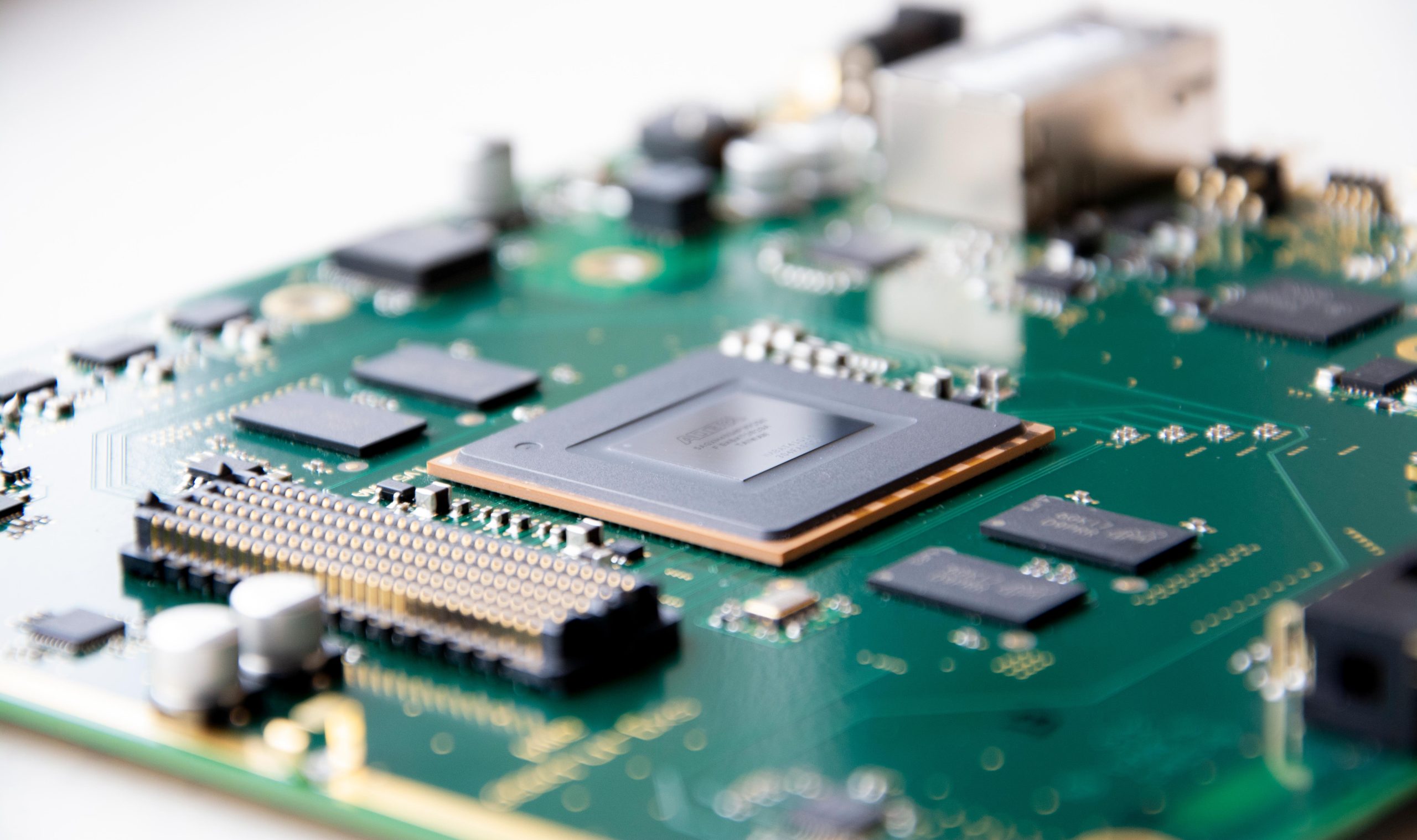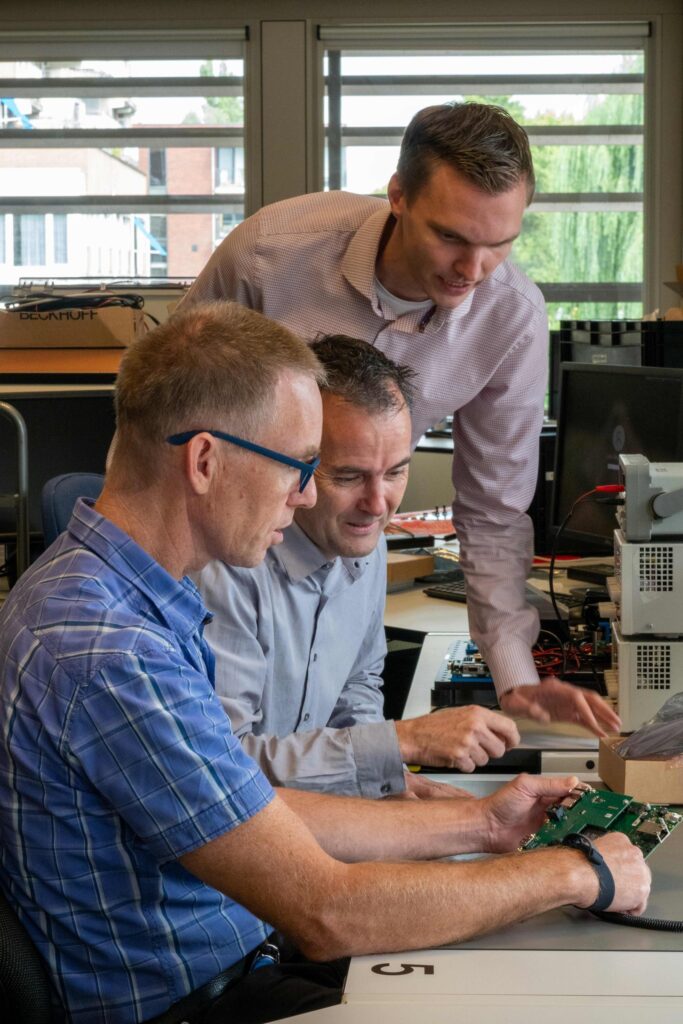
Smaller FPGAs are here to stay
FPGA manufacturing is trending toward the development of increasingly bigger, faster, data-crunching power beasts, tailored to the ever-growing needs of large data centers. However, smaller FPGAs are still very much around, and they have many useful applications. At Technolution the smaller FPGA type is considered to be an extremely flexible jack of all trades.
Reliable timing, high speeds, lower costs
“FPGAs are very useful when you have to work really close to the hardware in high-performance systems,” says Edwin Hakkennes. Edwin is a programmable logic specialist at Technolution Advance. He is currently working on a sensor that will measure voltage and current fluctuations in distribution substations in the electricity grid. It will perform these measurements at very high speeds and frequencies, enabling users to determine cable lengths to an accuracy of mere meters. In order to achieve this level of accuracy, two sensors at both ends of the cable exchange signals, measure the travel times of the signals, and calculate the length of the cable. Since the speed of the signals is about the same as the speed of light, the measurements in the sensors must be extremely fast and accurate. That is why FPGAs are used.
“With FPGAs we are able to process large volumes of data at very high speeds in many parallel threads at the same time,” Edwin says. “This creates a very high reliability in the timing of the processes, which is exactly what we need, because we are working with extremely short time intervals – think nanoseconds. If you are building an extremely fast system like this and you want to be 100 percent sure of your time synchronization, FPGAs are the way to go. They really come into their own in situations where you need speed, security and reliability.”
Sometimes just buying an existing processor is cheaper and faster. Not in this case though, Edwin points out: “We have been able to save a lot of money in this project by using an FPGA for the core calculations. It would have been very costly to design and build a dedicated ASIC for this purpose, and a standard processor that could fulfill all requirements was not available. So we implemented the required algorithms in programmable logic on the FPGA and combined the FPGA with two relatively cheap logic boards. It works like a charm. Of course, the FPGA also needs to be able to perform some basic chores beside the calculations, like processing ethernet, sending data over USB, et cetera. For these purposes we implemented an off-the-shelf basic softcore processor inside the FPGA.”
Keeping control of development effort
The investments in time and money for developing FPGA programming can be hard to control. A structured approach is advisable. In order to prevent unwanted delays, Technolution employs development methods that are tried and tested in software development, including automated testing procedures, a nightly build for regression testing, and a very thorough process of risk identification, problem solving and validation of the solutions.

More secure than software
FPGAs are also at the heart of Technolution’s high assurance products. According to Jan Jaap Treurniet, a security specialist at Technolution, FPGAs offer great security thanks to the predictability and reliability of the programmable logic. More so than software could ever do.
“If you want to be very sure that your encrypted data cannot be reached by hackers, you should look at FPGAs, say Jan Jaap. We develop encryption devices, data diodes and other high assurance solutions that are approved by the government for use with classified information. Thanks to FPGAs these products offer a level of security that would not be possible with software. The computation processes that are running on the FPGA simply cannot interfere with other processes. That’s because the different logical functions on the FPGA are separated, like separate rooms in the same building. They don’t mix. Once you have your programmable logic thoroughly tested and evaluated, you can trust that the outcome will always be what you expect it to be.”
There is another reason why FPGAs are especially suited for security applications. “On an FPGA, memory blocks containing data can be hard-linked to operations being performed”, explains Jan Jaap. “This is a crucial advantage when you build security solutions. In software-based security solutions, the data that you want to encrypt is stored in memory blocks that are connected to a generic processor. This means that in a software implementation, it is nearly impossible to guarantee that data only leaves a device after proper encryption. With the FPGAs in our high assurance products, the data on the FPGA is always processed and encrypted in a known series of operations that are implemented in a separate module with dedicated memory. If we go back to the building parallel: you always have to enter through the front door and pass through the hall to reach the living room. You cannot skip a room or take a shortcut. So the risk of leaks of unencrypted data is very small.”
But the advantages of FPGAs do not stop there. The possibility to reprogram FPGAs, even in existing devices that are already running in a production environment, is maybe their strongest selling point when it comes to security applications. They combine the security of hardware with the flexibility of software. “In cybersecurity, there are more advanced threats coming out every day,” Jan Jaap elaborates. “You have to be able to adapt. With FPGAs at the core of our devices, we can keep refreshing and enhancing the protection and encryption algorithms during the whole of the life cycle of the device. Customers only have to keep their devices updated with the latest firmware.”
Speed and security
For fast and secure encryption FPGAs are hard to beat. Technolution developed a FPGA-based line encryption device for secure connections that encrypts and transports data at 10 Gbps and a latency of less than 50 microseconds. Our encryption devices are approved by the Dutch government for classified information up to and including Top Secret information.
Some hard figures
Processing 10 Gbps up and down, the FPGA in the current SigmaXG handles 20 Gbps. This bandwidth is used by eight sub streams for viewing two simultaneous quad-view 4K screen views on two monitors, as well as many internal video pipes for scaling, composition and color space processing. With all this processing, including network transport and switching and mixing audio and video from different sources, the whole chain from transmitting device to receiving device still has a typical latency of less than 0.5 milliseconds.
Flexible features
Flexibility and adaptability were also key requirements for SigmaXG, Technolution’s video-over-IP solution. SigmaXG is tailored for use in hospitals, specifically operating rooms, where reliability and precision are crucial.
“We wanted to create a reliable, fast product with new features that the competition did not offer,” tells Eric Funke, project manager. “However, we did not want to develop an ASIC. ASICs would probably be faster, but the break-even point for developing ASICs lies at a production volume of approximately 100.000 devices. That is way above the kind of volumes we were aiming for. So we went for FPGAs.”
As it turned out, speed was not an issue. Processing video at speeds of up to 10 Gbit per second is no real challenge for a tightly programmed FPGA. SigmaXG can handle 4K video at 60 fps with a very low latency, offering seamless switching between video signals. Even at those speeds there is room to spare, says Eric. “We could easily process more than 10G if we needed to. The data pipelines in a FPGA are extremely fast. But for our customers – global electronics manufacturers that incorporate SigmaXG in their medical devices portfolios – the real strength of SigmaXG lies in the flexibility of the FPGA. If a hospital wants additional features, we can develop and integrate these really quickly, at a fraction of the cost of developing a new ASIC.”
The future of FPGAs
Developing and testing the programmable logic for FPGAs is greatly standardized at Technolution, so much so that the process looks a lot like software development, including automated testing protocols and nightly builds. Since FPGA manufacturers are now combining FPGAs with ‘normal’ processors, such as FPGAs with built-in ARM processors, Technolution expects that FPGA development will be even more streamlined in the future.
“In a sense, FPGAs offer the best of both worlds,” concludes Edwin. “The speed and reliability of a hardware solution, and the flexibility and upgradeability of software. Plus, they are very cost-effective. FPGAs are here to stay. With FPGAs, we create solutions that would not be possible in any other way.”
Our colleagues



